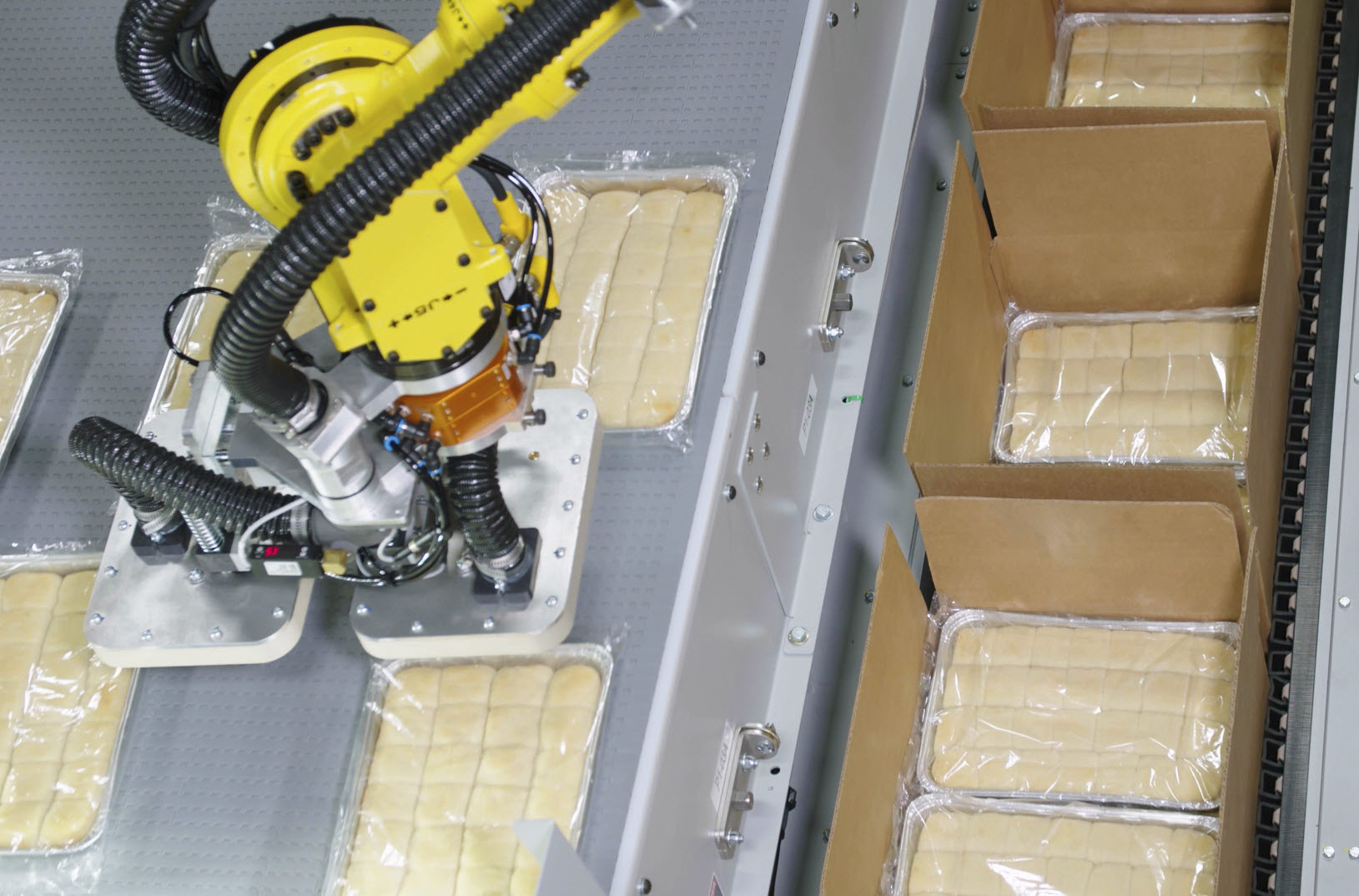Secondary Packaging in the Food and Beverage Industry
It all began for us over 65 years ago in the food and beverage market, and still today this sector is amongst the biggest focus areas for Pearson Packaging Systems. As a provider of automated secondary packaging solutions, our focus has always been on helping you:
- Meet throughput goals
- Control supply chain costs
- Bring products safely into retail locations around the country
- And ultimately into the hands of your end-customers
Over the years, the food and beverage industry has been impacted by several fundamental influences to accelerate the adoption of automation, specifically at the end of the line in secondary packaging. Strong market influences have also increased the need for flexibility and advanced support features offered by these packaging machines.

Increased Need For Automation
One of the most prevalent challenges to the food and beverage industry is the availability of labor. Manufacturing as a whole is dealing with a shortage of workers and the food and beverage industry is particularly affected. America’s working-age population is declining and immigrant workers who traditionally provided much of the food industry’s workforce are facing an adverse political climate. Not to mention the often unpleasant work environment of many food and beverage processing plants is unattractive to young people, marked by noise, extreme temperatures or strong odors. The lack of available labor is consequently reducing the general level of skill that manufacturers must source from. Frequent turnover and increased injuries intensify the need for investment in training, all the while minimum wages are rising. Yet industry margins are small and the pressure to keep product prices and production cost down is strong.
Automation reduces many of the stresses experienced by the food and beverage manufacturing industry. Secondary packaging, long able to maintain a cheap manual labor force, is now catching up with the implementation of automated packaging equipment. Automated packaging increases efficiencies, reduces costs, and lowers the unnecessary exposure to the vulnerability of a tightening labor market and its associated costs and risks. Pearson Packaging Systems is uniquely positioned to support the food and beverage industry as a single-source supplier for end-of-line packaging equipment and turnkey systems. Our portfolio addresses case forming, packing, closing and palletizing. For turnkey systems, we have an integration group with specialized expertise and large scale project management capability.
Increased Need For Packaging Equipment Flexibility
Retail outlets from bulk-selling warehouse clubs to small-scale convenience stores are demanding case styles and pack patterns that fit their business model. In addition, retailers are increasingly shifting the responsibility for product shelf-presence to the manufacturers in an attempt to reduce supply chain costs. The introduction of retail-ready or shelf-ready display packaging with vertical pack patterns created unique obstacles for many food manufacturers. And if that is not challenging enough, frequently changing consumer preferences are forcing savvy food and beverage marketers to continually innovate and disrupt.
The resulting proliferation of SKUs has significantly increased the number of changeovers per day or shift. Since every changeover means downtime, fast changeovers with minimal or no human intervention are highly sought after. But the much-needed flexibility doesn’t stop there. Modern automated lines have to have growth capacity built-in, do more in less space, require less maintenance, and offer remote support capability.
Pearson Packaging Systems understands the challenges food and beverage manufacturers face and constantly advances time tested equipment designs by adopting new technologies that increase flexibility, offer automatic changeover, decrease footprints, and provide remote service support.
Increased Need For Handling Flexible Products
Customers are increasingly environmentally conscious and demanding reduced waste from packaging. This trend, while maybe challenging for packaging designers, complements the material cost reduction efforts of manufacturers. The result? A huge shift to flexible packaging.
According to a 2019 market assessment from PMMI 19 percent of the overall packaging market consists of flexible packaging. The same report stated that by 2023, this format will grow at a 3.9 percent compound annual growth rate (CAGR). The food and beverage industry features the highest rate of end-use flexible packaging utilization, implementing almost half of all flexible packaging.
Flexible packaging has unique characteristics including the plasticity of the material and product, individual shapes of the product and the sheen and reflection of the plastic wrapping.
Pearson Packaging Systems exclusively addresses top-loaded packaging applications, which uniquely lends itself to flexible product loading that cannot be pushed or squared without damage. For over 30 years, Pearson has developed extensive flexible product handling expertise utilizing robotics and vision and line tracking to gently pick and place products to achieve even challenging pack patterns such as interleaving and shingling.
The Pearson Solution
Leading food and beverage manufacturers choose Pearson Packaging Systems to benefit from:
- User-optimized human-machine interfaces (HMIs): To make your interaction with your packaging line as intuitive as possible, Pearson machines feature HMIs with User-Centric Design (UCD). These advanced HMIs improve ease of use through straightforward design, interactive guides, advanced maintenance features and easy navigation.
- Extensive industry experience and training: Pearson solutions are built on 65 years of erecting, packing and sealing equipment and 30 years of robotic integration history. Pearson is a certified FANUC service provider with extensive training on FANUC robot servicing.
- Premier lead times and customer service: You can expect fast lead times from Pearson that promote quicker delivery and shorter down-payment cycles. Some equipment is available in as little as 30 days. Your Pearson technical support team is available 24/7 for live service support.
- Continuous support: During the build-phase, your project managers will offer ongoing visibility to ensure that your budget and timeline will be met. Throughout your experience with Pearson, count on dedicated support from our sales, aftermarket and technical service team.
